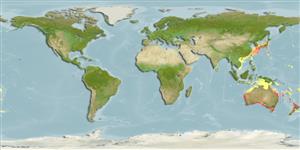>
Eupercaria/misc (Various families in series Eupercaria) >
Callanthiidae (Splendid perches)
Etymology: Callanthias: Greek, kalos, kallos = beautiful + Greek, anthias = a fish (Sparus aurata) (Ref. 45335).
More on author: Ogilby.
Environment: milieu / climate zone / depth range / distribution range
Ecologia
marinhas associadas(os) a recifes; intervalo de profundidade 15 - 365 m (Ref. 9832). Subtropical
Western Pacific: off New Zealand and temperate waters off Australia; also known from one collection made northeast of Rockhampton, Queensland, Australia, and from one collection in the Chesterfield Island region of the Coral Sea; may reach Indonesian waters. Closely related to Callanthias japonicus from Japanese waters and from Callanthias platei from the southeast Pacific; all three taxa may be subspecies of a single wide-ranging species.
Tamanho / Peso / Idade
Maturity: Lm ? range ? - ? cm
Max length : 49.0 cm SL macho/indeterminado; (Ref. 33839); common length : 18.0 cm SL macho/indeterminado; (Ref. 9832)
Espinhos dorsais (total) : 11; Raios dorsais (total) : 10 - 12; Espinhos anais: 3; Raios anais : 10 - 11; Vértebras: 24. Continuous dorsal fin, typically 11 dorsal- and anal-fin rays, and an emarginate caudal fin with elongate outer rays (Ref. 33616).
A schooling species which seeks the cover of caves and crevices at night and when disturbed. Often found on rocky reefs in coastal waters (Ref. 33616). Presumably feed on plankton.
Ciclo de vida ou comportamento de acasalamento
Maturities | Reprodução | Spawnings | Egg(s) | Fecundities | Larvas
Anderson, W.D. Jr., 1999. Callanthiidae. Groppos, goldies, splendid perches. p. 2553-2556. In K.E. Carpenter and V.H. Niem (eds.) FAO species identification guide for fishery purposes. The living marine resources of the Western Central Pacific. Volume 4. Bony fishes part 2 (Mugilidae to Carangidae). FAO, Rome. (Ref. 9832)
Status na Lista Vermelha da UICN (Ref. 130435)
Ameaça para os humanos
Harmless
Uso pelos humanos
Ferramentas
Relatórios especiais
Baixar XML
Fontes da internet
Estimates based on models
Preferred temperature (Ref.
123201): 13.7 - 22.5, mean 15.9 °C (based on 164 cells).
Índice de diversidade filogenética (Ref.
82804): PD
50 = 0.5039 [Uniqueness, from 0.5 = low to 2.0 = high].
Bayesian length-weight: a=0.00977 (0.00387 - 0.02465), b=3.08 (2.86 - 3.30), in cm total length, based on LWR estimates for this (Sub)family-body shape (Ref.
93245).
Nível Trófico (Ref.
69278): 3.1 ±0.30 se; based on food items.
Fishing Vulnerability (Ref.
59153): Moderate vulnerability (44 of 100).
Nutrients (Ref.
124155): Calcium = 29 [16, 48] mg/100g; Iron = 0.732 [0.435, 1.198] mg/100g; Protein = 19.4 [18.4, 20.5] %; Omega3 = 0.23 [0.13, 0.38] g/100g; Selenium = 28.8 [14.3, 55.3] μg/100g; VitaminA = 43.2 [15.2, 123.7] μg/100g; Zinc = 0.808 [0.545, 1.159] mg/100g (wet weight);
